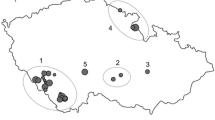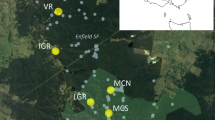Abstract
We studied population viability in relation topopulation size and allelic variation in thenarrowly-endemic, monocarpic perennial plantCochlearia bavarica in Bavaria. In 1996,we analysed allelic variation by allozymeelectrophoresis in 24 populations ranging from8–2000 flowering individuals. Fitness-relatedcharacters were investigated in 22 of the 24populations in the field in 1996 (reproductiveand vegetative traits) and 1998 (reproductivetraits only). Differences in allozyme patternwere large between a south-eastern and awestern population group. Genetic diversity,assessed by the Shannon-Wiener diversity index,was low within but high among populations.Small populations had fewer alleles per locus,fewer polymorphic loci, lower observedheterozygosity, and lower genetic diversitythan large populations. Environmentalvariables were not significantly correlatedwith population size or fitness with theexception of light availability, indicatingthat habitat quality was similar for large andsmall populations. Population size showedpositive correlations with number of flowers,fruit set per plant, number of seeds per fruit,and total seed output per plant. Fruit set andnumber of seeds per fruit were positivelycorrelated with the observed heterozygosity andthe proportion of polymorphic loci. We usedpath analyses to study the possible causalrelationships among population size, allelicvariation, and reproductive characters. Thesemodels showed that allelic variation had nodirect influence on reproductive characters,whereas population size did. We conclude thatat present population size reduces viabilityand also reduces allelic variation; but thereduced allelic variation may in the longerterm have negative feed-backs on bothpopulation size and viability.
Similar content being viewed by others
References
Abs C (1999) Differences in the life history of two Cochlearia-species. In: Ecology of closely related plant species (eds. Marhold K, Schmid B, Krahulec F), pp. 33–45. Opulus Press, Uppsala.
Ågren J (1996) Population size, pollinator limitation and seed set in the self-incompatible herb Lythrum salicaria. Ecology, 77, 1779–1790.
Aizen MA, Feinsinger P (1994) Forest fragmentation, pollination and plant reproduction in a Chaco dry forest, Argentina. Ecology, 75, 330–351.
Barrett SCH, Kohn JR (1991) Genetic and evolutionary consequences of small population size in plants: Implications for conservation. In: Genetics and conservation of rare plants (eds. Falk DA, Holsinger KH), pp. 3–30. Oxford University Press, Oxford.
Bentler PM (1995) EQS Structural Equations. Encino, California.
Buza L, Young A, Thrall, P (2000) Genetic erosion, inbreeding and reduced fitness in fragmented species of the endangered tetraploid pea Swainsona recta. Biol. Conserv., 93, 177–186.
Campbell DR, Halama JH (1993) Resource and pollen limitation to lifetime seed production in a natural plant population. Ecology, 74, 1043–1051.
Dolan RW (1994) Patterns of allozyme variation in relation to population size, isolation and phytogeographic history in royal catchfly Silene regia: Caryophyllaceae). Am. J. Bot., 81, 965–972.
Ellstrand NC, Elam DR (1993) Population genetic consequences of small population size: Implication for plant conservation. Annu. Rev. Ecol. Syst., 24, 217–242.
Falconer DS (1989) Introduction to Quantitative Genetics, 2nd edn. Longman, London.
Frankham R (1996) Relationship of allelic variation to population size in wildlife. Conserv. Biol., 10, 1500–1508.
Fischer M, Stöcklin J (1997) Local extinction of plants in remnants of extensively used calcareous grassland 1950–1985. Conserv. Biol., 11, 727–737.
Fischer M, Matthies D (1998a) Effects of population size on performance in the rare plant Gentianella germanica. J. Ecol., 86, 195–204.
Fischer M, Matthies D (1998b) RAPD variation in relation to population size and plant performance in the rare Gentianella germanica. Am. J. Bot., 85, 811–819.
Fischer M, Husi R, Prati D, Peintinger M, van Kleunen M, Schmid B (2000) RAPD variation among and within small and large populations of the rare clonal plant Ranunculus reptans (Ranunculaceae). Am. J. Bot., 87, 1128–1137.
Fischer M, Hock M, Paschke M (submitted) Low genetic variation reduces cross-compatibility and offspring fitness in populations of a narrow endemic self-incompatible plant.
Fritz AL, Nilsson A (1994) How pollinator-mediated mating varies with population size in plants. Oecologia, 100, 451–462.
Gillet EM (1994) Genetic Structures from Electrophoresis Data (GSE). Version 1.1.b. Göttingen.
Gilpin ME, Soulé ME (1986) Minimum viable populations: Processes of extinction. In: Conservation Biology: The Science of Scarcity and Diversity (ed. Soulé ME), pp. 19–34. Sinauer, Sunderland.
Gorchov DL (1988) Effects of pollen and resources on seed set and other fitness components in Amelanchier aborea (Rosaceae: Maloideae). Am. J. Bot., 75, 1275–1285.
Groom MJ (1998) Allee effects limit population viability of an annual plant. Am. Nat., 151, 487–495.
Hamrick JL, G odt MJW(1989) Allozyme diversity in plant species. In: Plant Population Genetics, Breeding and Genetic Resources (eds. Brown AHD, Clegg MT, Kahler AL, Weir BS), pp. 43–46. Sinauer, Sunderland.
Jennersten O (1988) Pollination in Dianthus deltoides (Carophyllaceae): Effects of habitat fragmentation on visitation and seed set. Conserv. Biol., 4, 359–366.
Jennersten O, Nilsson SG (1993) Insect flower visitation frequency and seed production in relation to patch size of Viscaria vulgaris (Carophyllaceae). Oikos, 68, 283–292.
Karron JD (1987) A comparison of levels of genetic polymorphism and self-compatibility in geographically restricted and widespread plant congeners. Evol. Ecol., 1, 47–58.
Kéry M, Matthies D, Spillmann HH (2000) Reduced fecundity and offspring performance in small populations of the declining grassland plants Primula veris and Gentiana lutea. J. Ecol., 88, 17–30.
Koch M, Hurka H, Huthmann M (1998) Isozymes, speciation and evolution in the polyploid complex Cochlearia L. (Brassicaceae). Bot. Acta, 111, 411–425.
Kunin WE (1997) Population size and density effects in pollination: Pollinator foraging and plant reproductive success in experimental arrays of Brassica kaber. J. Ecol., 85, 225–234.
Lacy RC (1987) Loss of genetic diversity from managed populations: Interacting effects of drift, mutation, immigration, selection and population subdivision. Conserv. Biol., 1, 143–158.
Lammi A, Siikamaki P, Mustajarvi K. (1999) Genetic diversity, population size, and fitness in central and peripheral populations of a rare plant Lychnis viscaria. Conserv. Biol., 13, 1069–1078.
Leberg PL (1996) Applications of Allozyme Electrophoresis in Conservation Biology. In: Molecular Genetic Approaches in Conservation (eds. Smith TB, Wayne RK), pp. 87–103. Oxford University Press, Oxford.
Lynch M, Conery J, Bürger R (1995) Mutational meltdowns in sexual populations. Evolution, 49, 1067–1080.
Manly BFJ (1991) Randomization and Monte Carlo Methods in Biology. Chapman and Hall, London.
Menges ES (1990) Population viability analysis for an endangered plant. Conserv. Biol., 4, 52–62.
Menges ES (1991a) The application of minimum viable population theory to plants. In: Genetic and Conservation of Rare Plants (eds. Falk DA, Holsinger KH), pp. 45–61. Oxford University Press. Oxford.
Menges ES (1991b) Seed germination percentage increases with population size in a fragmented prairie species. Conserv. Biol., 5, 158–164.
Morgan JW (1999) Effects of population size on seed production and germinability in an endangered, fragmented grassland plant. Conserv. Biol., 13, 266–273.
Müller-Starck G (1997) Allozymes. In: Molecular Tools for screening Diversity: Plants and Animals (eds. Karp A, Isaac PG, Ingram DS), pp. 75–81. Chapman and Hall, London.
Olesen JM, Jain SK (1994) Fragmented plant populations and their lost interactions. In: Conservation Genetics (eds. Loeschke V, Tomiuk J, Jain SK), pp. 417–426. Birkhäuser, Basel.
O'Neil P (1994) Genetic incompatibility and offspring quality in the tristylous plant Lythrum salicaria (Lythraceae). Am. J. Bot., 81, 76–84.
Oostermeijer JGB, den Nijs JCM, Raijman LEL, Menken SBJ (1992) Population biology and management of the marsh gentian Gentiana pneumonanthe L., a rare species in The Netherlands. Bot. J. Linn. Soc., 108, 117–129.
Oostermeijer JGB, Van Eijck MW, Den Nijs JCM (1994) Offspring fitness in relation to population size and allelic variation in the rare perennial plant species Gentiana pneumonanthe (Gentianaceae). Oecologia, 97, 289–296.
Oostermeijer JGB, Van Eijck MW, Van Leeuwen NC, Den Nijs JCM (1995) Analysis of the relationship between allozyme heterozygosity and fitness in the rare Gentiana pneumonanthe L. J. Evol. Biol., 8, 739–759.
Oostermeijer JGB, Berholz A, Poschlod P (1996) Genetic aspects of fragmented plant populations. In: Species Survival in Fragmented Landscapes (eds. Settele CR, Poschlod P, Henle K), pp. 93–101. Kluwer Academic Publishers, Amsterdam.
Ouborg NJ, Van Treuren R (1994) The significance of genetic erosion in the process of extinction IV: Inbreeding load and heterosis in relation to population size in the mint Salvia pratensis. Evolution, 48, 996–1008.
Payne RW (1993) Genstat 5, Version 3. Reference Manual. Clarendon Press, Oxford.
Pitelka LF, Stanton DS, Peckenham MO (1980) Effects of light and density on resource allocation in a forest herb, Aster acuminatus (Compositae). Am. J. Bot., 67, 942–948.
Raijmann LLE, Van Leeuwen NC, Kersten R, Oostermeijer JGB, Den Nijs HCM, Menken SBJ (1994) Allelic variation and outcrossing rate in relation to population size in Gentiana pneumonanthe. Conserv. Biol., 8, 1014–1026.
Rajora OP, Mosseler A, Major JE (2000) Indicators of population viability in red spruce, Picea rubens. II. Genetic diversity, population structure, and mating behavior. Can. J. Bot., 78, 941–956.
Roger DL (1997) Inheritance of allozymes from seed tissues of the hexaploid gymnosperm Sequoia sempervirens (Coast redwood). Heredity, 78, 166–175.
Savolainen O, Henrick P (1995) Heterozygotes and fitness: No association in scots pine. Genetics, 140, 755–766.
Schmidt K, Jensen K (2000). Genetic structure and AFLP variation of remnant populations in the rare plant Pedicularis palustris (Scrophulariaceae) and its relation to population size and reproductive components. Am. J. Bot., 87, 678–689.
Shannon CE, Wiener W (1949) The Mathematical Theory of Communication. University of Illinois Press, Urbana.
Shaffer ML (1981) Minimal population sizes for species conservation. BioScience, 31, 131–134.
Sobrevila C (1988) Effects of distance between pollen donor and pollen recipient on fitness components in Espeletia schultzii. Am. J. Bot., 75, 701–724.
Sokal RR, Rohlf FJ (1981) Biometry. Freeman, San Francisco, California.
Stebbins GL (1980) Polyploidy in plants: Unsolved problems and prospects. In: Polyploidy: Biological Relevance (ed. Lewis WH), pp. 495–520. New York.
Sun M (1996) Effects of population size, mating system, and evolutionary origin on genetic diversity in Spiranthes sinensis and S. hongkongensis. Conserv. Biol., 10, 785–795.
Van Treuren R, Bijlsma R, Ouborg NJ, Van Delden W (1991) The significance of genetic erosion in the process of extinction: I. Genetic differentiation in Salvia pratensis L. and Scabiosa columbaria L. in relation to population size. Heredity, 66, 181–189.
Van Treuren R, Bijlsma R, Ouborg NJ, Van Delden W (1993) The significance of genetic erosion in the process of extinction. IV. Inbreeding depression and heterosis effects caused by selfing and outcrossing in Scabiosa columbaria. Evolution, 47, 1669–1680.
Vogt R (1985) Die Cochlearia pyrenaica-Gruppe in Zentraleuropa. Ber. Bayer. Bot. Ges., 59, 133–135.
Washitani I, Osawa R, Namai H, Niwa M (1994) Patterns of female fertility in heterostylous Primula sieboldii under severe pollinator limitation. J. Ecol., 82, 571–579.
Williamson PS, Werth CR (1999) Levels and patterns of allelic variation in the endangerd species Abronia macrocarpa (Nyctaginaceae). Am. J. Bot., 86, 293–301.
Wolfe LM (1995) The genetics and ecology of seed size variation in a biennial plant, Hydrophyllum appendiculatum (Hydrophyllaceae). Oecologia, 101, 343–352.
Young A, Boyle T, Brown T (1996) The population genetic consequences of habitat fragmentation for plants. Tr. E. E., 11, 413–418.
Author information
Authors and Affiliations
Corresponding author
Rights and permissions
About this article
Cite this article
Paschke, M., Abs, C. & Schmid, B. Relationship between population size, allozyme variation, and plant performance in the narrow endemic Cochlearia bavarica . Conservation Genetics 3, 131–144 (2002). https://doi.org/10.1023/A:1015293530776
Issue Date:
DOI: https://doi.org/10.1023/A:1015293530776




